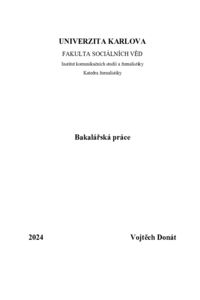Mediální obraz uzavření Opoziční smlouvy ve vybraných českých médiích
Media Image of the so-called Opposition Agreement In Czech Media
bakalářská práce (OBHÁJENO)

Zobrazit/
Trvalý odkaz
http://hdl.handle.net/20.500.11956/191061Identifikátory
SIS: 263146
Kolekce
- Kvalifikační práce [18370]
Autor
Vedoucí práce
Oponent práce
Osvaldová, Barbora
Fakulta / součást
Fakulta sociálních věd
Obor
Komunikační studia se specializací Žurnalistika
Katedra / ústav / klinika
Katedra žurnalistiky
Datum obhajoby
17. 6. 2024
Nakladatel
Univerzita Karlova, Fakulta sociálních vědJazyk
Čeština
Známka
Výborně
Tato bakalářská práce se zabývá mediálním obrazem uzavření Smlouvy o vytvoření stabilního politického prostředí v České republice, která bývá běžně označována jako Opoziční smlouva. Tato smlouva vznikla po volbách do Poslanecké sněmovny Parlamentu ČR. Její hlavní myšlenkou bylo, že Občanská demokratická strana umožní České straně sociálně demokratické sestavit menšinovou vládu. První část práce je věnována mediální teorii, problematice masové komunikace a jejímu vlivu na konstrukci reality. Analytická část práce se věnuje nejprve pozadí přijetí Opoziční smlouvy. Dále zkoumá, jakým způsobem o Opoziční smlouvě informovaly vybrané deníky. Těmito deníky jsou Mladá fronta Dnes, Hospodářské noviny, Právo a Blesk. Daná média byla vybrána na základě různorodosti, co se týče čtenářů, ale i vlastnických struktur. Ke zodpovězení výzkumných otázek je využito metod kvantitativní obsahové analýzy. Cílem práce je zachytit atmosféru bezprostředně spjatou s podpisem Opoziční smlouvy, ke kterému došlo 9. července 1998. V rámci obsahové analýzy jsou v práci zachyceny aspekty podpisu Opoziční smlouvy, které byly zdůrazňovány v článcích a jsou tříděny podle zdroje. Na poznatky získané touto prací lze navázat v pracích budoucích.
This bachelor's thesis deals with the media image of the signing of the Agreement on the Creation of a Stable Political Environment in the Czech Republic, commonly referred to as the Opposition Agreement. This agreement arose after the elections to the Chamber of Deputies of the Parliament of the Czech Republic. Its main idea was that the Civic Democratic Party would enable the Czech Social Democratic Party to form a minority government. The first part of the thesis is dedicated to media theory, the issues of mass communication, and its influence on reality construction. The analytical part of the thesis first addresses the background of the adoption of the Opposition Agreement. It then examines how selected newspapers reported on the Opposition Agreement. These newspapers include Mladá fronta Dnes, Hospodářské noviny, Právo, and Blesk. These media outlets were chosen for their diversity in terms of readership and ownership structures. Quantitative content analysis methods are used to answer the research questions. The aim of the thesis is to capture the atmosphere directly associated with the signing of the Opposition Agreement, which took place on July 9, 1998. Within the content analysis, the thesis captures aspects of the signing of the Opposition Agreement emphasized in the articles and...
